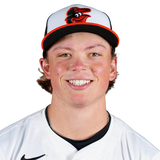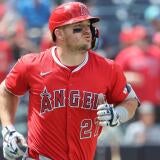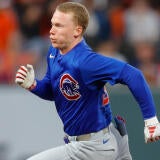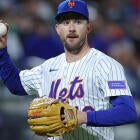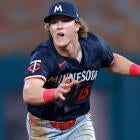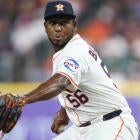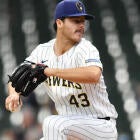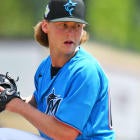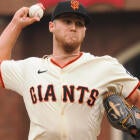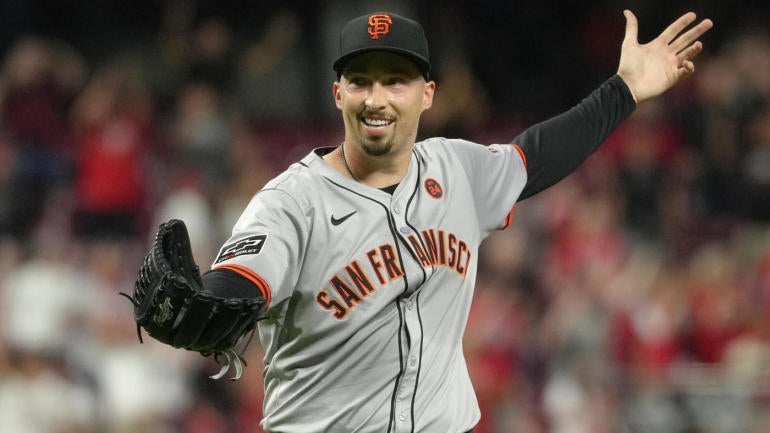
A pitcher who throws a no-hitter is almost certain kick off the Weekend Stockwatch, even if only to point out that his outlook didn't actually change with the performance.
But the pitcher in this instance is one whose outlook is constantly changing, Blake Snell. The reigning NL Cy Young winner looked like anything but for his first six starts, but then again, that's kind of how things played out for him last year ... and the year before ... and the year before.
To put actual numbers to it, here's how Snell has begun each of the past four seasons:
| | ERA | WHIP | Starts |
2021 | 5.44 | 1.61 | 19 |
2022 | 5.22 | 1.48 | 10 |
2023 | 5.04 | 1.56 | 10 |
2024 | 9.51 | 1.94 | 6 |
And here's how he's closed out each of the past four seasons:
| | ERA | WHIP | Starts |
2021 | 1.83 | 0.77 | 8 |
2022 | 2.19 | 1.03 | 14 |
2023 | 1.18 | 1.05 | 22 |
2024 | ??? | ??? | ??? |
This current season is still in progress, of course, but Friday's no-hitter completed what has to be one of the most dominant two-start stretches in major-league history. Snell's previous outing saw him strike out 15 over six shutout innings.
In fact, each of his past five starts has been "good," in a broad sense. So, then ... here we go again?
You see the numbers from his past five starts. You've seen how each of his past three seasons has turned on a dime. All that's left to say is how Blake Snell should rank the rest of the way, and for me, it's top 15. I'd show more restraint, fearful of him reverting to his more erratic form, if this movie hadn't played out so many times before. It's more Christopher Robin than Christopher Nolan. That twist ending isn't coming. Perhaps I'm falling prey to a sort of gambler's fallacy, but then again, Snell's talent is blatantly obvious. The disastrous stretches are more confounding than the dominant ones. It just seems like he needs a few outings to figure out what's working for him in a given year, and this year, it seems to be his curveball. Who am I to argue?
| ||||||||||||
The consensus No. 1 overall prospect coming into the year, Jackson Holliday struggled in his first big-league opportunity back in April, going 2 for 34 with 18 strikeouts. His return has been a night-and-day difference, beginning with a 439-foot grand slam in his first game back Wednesday and continuing with three straight multi-hit games (along with his second home run) over the weekend. "I'm starting to see the ball a little deeper and allowing myself to go the other way, which allows me to see the ball for a longer time," Holliday said. "Honestly, a whole lot more comfortable." Of Holliday's 13 batted balls in his five games since returning, 11 have met the Statcast definition of hard hit, registering an exit velocity of 95 mph or higher. Hitting prospects, no matter how high-end, have almost universally struggled to break into the majors this season, but Holliday is once again deserving of all the optimism you can muster.
| ||||||||||||
After a rookie season that saw him hit 21 homers but with only a .209 batting average, Anthony Volpe came into this season with a flatter swing that he hoped would deliver a more balanced stat line. But after piling up some multi-hit games early on, he wound up hitting just .224 with a .604 OPS from mid-April to mid-July, 82 games in all, which had him on the outs in Fantasy. He may have reinvented himself again over the All-Star break. He's back to pulling the ball in the air, has picked up more than 1 mph in average exit velocity, and has nearly doubled his season home run total in just 15 games. There's been a rush to judge Volpe throughout his big-league career, pigeonholing him as one type of hitter or another, when he mostly just seems like a work in progress. Clearly, he's deserving of another look in Fantasy.
| ||||||||||||
Beyond just the 11 strikeouts and career-high 26 swinging strikes, Yusei Kikuchi's debut for the Astros this weekend may have revealed why the impending free agent fetched so much at the trade deadline. Sometimes a new organization will see things that the old one didn't, and for Kikuchi with the Astros, that something is the effectiveness of his changeup. He threw it 26 percent of the time vs. the usual 11 percent, and it was responsible for 11 of his 26 whiffs. Manager Joe Espada made clear afterward that it wasn't just happenstance. "The changeup, I thought, was the game-changer for me," Espada said. "That's kind of what we wanted him to do, was throw the changeup more in-zone. It's a really, really good pitch and that just makes his fastball a much better pitch." The Astros have knack for unlocking pitchers' potential, and Kikuchi may just be the latest example.
| ||||||||||||
There was talk earlier this year of Manny Machado being washed up at 32, and in fairness, he had just six home runs and a .662 OPS as late as June 18. All of a sudden, his pace isn't so different from a year ago. It's taken some doing to get there -- over his past 36 games, he's batting .322 (46 for 143) with 11 homers and a .976 OPS, capped by a 5-for-10 performance this weekend -- but now that he's there, he may cruise to numbers even more in line with the rest of his career. Last year was a down year, remember, because he was playing through a case of tennis elbow, the same injury for which he had surgery prior to this year. That presumed decline was more likely a case of him playing at less than full capacity, and I'm going to bet he's a Fantasy stud from this point forward.
| ||||||||||||
Spencer Arrighetti was already trending the right direction, but this latest outing is enough to command an immediate recalibration of his Fantasy value. The 12 strikeouts and 20 swinging strikes both represent a new high for the rookie, and what made them possible was reducing the use of his worst pitch, the fastball, while increasing the use of his best pitch, the curveball. The latter has yielded only a .160 batting average with a 41.1 percent whiff rate. Whether Arrighetti sticks with the approach remains to be seen, but he now has a 3.41 ERA, 1.21 WHIP and 11.2 K/9 in his past five starts. Walks remain a significant hurdle, but now he's showing the sort of bat-missing potential to succeed in spite of them and is deserving of a roster spot even in 12-team leagues.
| ||||||||||||
Wilyer Abreu's earlier momentum was quashed by an ankle injury that cost him three weeks in June, but it's looking more and more like it was only a temporary setback. After a huge weekend that saw him go 5 for 11 with three home runs, he's batting .346 (19 for 55) with six homers in his past 19 games. The power is legitimate, too, with his average exit velocity measuring in the 83rd percentile and his max exit velocity in the 93rd percentile. There is the matter of him hardly ever playing against left-handers, which means you'll have to pick your spots with him, but Abreu once again demands to be rostered in all five-outfielder and daily-lineup leagues.
| ||||||||||||
There's a concerted effort to manage Crochet's workload given that he's already exceeded his career high by more than 50 innings, and the last time we saw him go more than four in a start was June 30. Though he was an ace or something close to it for the first three months, he's difficult to trust now, to the point you may no longer want to dedicate a roster spot to him in shallower leagues. I will note, though, that he hasn't actually pitched well in his last two outings, struggling to throw strikes in this latest one. Manager Pedro Grifol confirmed afterward that Crochet had 75 pitches to work with and used them all up in four innings. If he was as dominant as earlier this season, he might have lasted five or even six. He may deliver another such start before the year is done, but he has little margin for error, clearly.
| ||||||||||||
The six-start stretch depicted above may not seem so concerning at first glance, but during that time, Cole Ragans' velocity has been down 1.5-2 mph on average. It was easy to dismiss at first because the second and third starts of that six-start stretch were so dominant, but the fourth, fifth and sixth have been fairly unimpressive. My initial theory was that he was trading off some velocity to command his pitches better, but he's thrown only 61 percent of his pitches for strikes during this six-start stretch compared to 65 percent before it. And seeing as a jump in velocity fueled his breakthrough last year, I'm wondering if that's a tradeoff he can afford anyway. There's no need to panic with Ragans yet, but there is a need for a high alert and to plan for the possibility he's no longer an ace for you down the stretch.
| ||||||||||||
What made Tanner Houck so effective for the first half of the year -- when he put together a 2.18 ERA, 0.97 WHIP and 8.8 K/9 over the first three months -- was his usual high ground-ball rate combined with vastly improved control. That control has slipped in his past six starts, during which he has issued 17 of his 35 walks this season en route to a 6.16 ERA. This latest start was a little bit different, though. He threw 72 percent of his pitches for strikes compared to 59 percent in his previous five, which are basically opposite ends of the spectrum. It's more the home runs that burned him, which won't be the norm given his ground-ball rate. Afterward, Houck acknowledged a renewed emphasis on pounding the zone, offering hope of a possible turnaround, but it's going to take a quality outing or two to get him back in Fantasy lineups.
| ||||||||||||
![[object Object] Logo](https://sportshub.cbsistatic.com/i/2020/04/22/e9ceb731-8b3f-4c60-98fe-090ab66a2997/screen-shot-2020-04-22-at-11-04-56-am.png)




